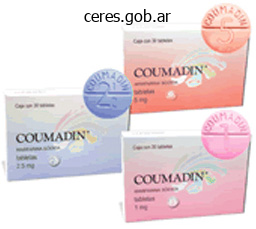
General Information about Coumadin
Blood clotting is a traditional and important process that happens in the body to cease bleeding. It involves a mixture of platelets (small blood cells) and proteins within the blood known as clotting factors. When an injury happens, the platelets and clotting components work together to type a clot, which stops the bleeding and helps the wound to heal. However, if a blood clot varieties inside a blood vessel without an harm, it could turn into a critical well being concern.
Coumadin works by inhibiting the activity of vitamin K, which is important for the production of certain clotting elements in the blood. Without these components, it takes longer for blood to clot, thus reducing the risk of harmful clots forming. It is often prescribed for patients who are at high risk of creating blood clots, similar to those that have had a heart valve alternative, or these with a condition that increases the chance of clotting, such as atrial fibrillation.
Upon starting Coumadin treatment, patients are usually fastidiously monitored via regular blood checks to examine their International Normalized Ratio (INR). This is a measure of how long it takes for the blood to clot, and a stable and particular INR vary is maintained depending on the affected person's situation. The dose of Coumadin is adjusted in accordance with the INR results to guarantee that the blood is clotting at a protected and effective rate.
It is necessary to take Coumadin exactly as prescribed by a healthcare provider, as it can have critical side effects if not taken appropriately. For example, taking too much Coumadin can increase the risk of bleeding, while taking too little can increase the danger of clot formation. Patients should also concentrate on potential interactions with different drugs, natural supplements, and foods that may affect the effectiveness of Coumadin.
While Coumadin is very effective in preventing harmful blood clots, it isn't appropriate for everybody. Patients with a historical past of bleeding problems, hypertension, liver or kidney disease, or those who are pregnant or breastfeeding mustn't take Coumadin. It is essential to discuss any medical circumstances and medications with a healthcare supplier before starting Coumadin therapy.
There are a quantity of explanation why blood clots could form within the physique, including certain medical situations (such as atrial fibrillation and coronary heart valve problems), prolonged immobility, and surgical procedure. If a blood clot types in a vein, it may possibly block blood circulate and trigger swelling, ache, and redness within the affected space. This is called venous thrombosis and can lead to serious complications if left untreated, similar to a condition known as pulmonary embolism the place the clot travels to the lungs and could be life-threatening.
Coumadin, also called warfarin, is a extensively used medicine for the therapy and prevention of dangerous blood clots. These clots can happen in various elements of the physique, such as the veins, lungs, and heart. In order to grasp how Coumadin works, it may be very important first perceive what blood clots are and why they can be harmful.
In conclusion, Coumadin is a generally prescribed medication for preventing and treating harmful blood clots. By inhibiting the exercise of vitamin K, it reduces the danger of clots forming and may forestall critical problems similar to pulmonary embolism. However, correct monitoring and adherence to the prescribed dosage is crucial for secure and efficient therapy. Patients should all the time seek the advice of with their healthcare supplier and follow their directions fastidiously to realize the very best consequence.
When relaxed, it pulls a set of zonular fibers attached to the elastic lens taut and flattens the lens for viewing objects at some distance from the eye. The subarachnoid space extends along the nerve to the point where it attaches to the posterior aspect of the eyeball. Diabetic retinopathy is the number-one cause of blindness in middle-aged individuals and the fourth leading cause of blindness overall in the United States. Complications: retinal detachment Vitreous contraction Fibrovascular proliferation and hemorrhage-vitreoretinal traction Fibrovascular proliferation and vitreous contraction cause traction retinal detachment. Open angle Wide open angle Pseudoexfoliation material Lens protein and macrophages Pigment particles Lens-induced glaucoma Gonioscopy reveals open angle without evidence of obstruction Hypermature cataract Pigment-induced glaucoma Primary closed angle Corneal edema Acute angle closure results in marked increase in intraocular pressure with conjunctival hyperemia, corneal edema, and fixed middilated pupil. Optically, the cornea, lens, and axial length of the eyeball must be in precise balance to achieve sharp focus on the macula. Normal eye (emmetropia) Cornea Light rays are bent (refracted) by cornea and lens (primarily cornea) to focus image on macular portion of retina. Distant target Near target Macula Lens Elasticity of lens allows it to change shape in order to focus divergent rays from near targets. Myopia: If corneal curvature is too steep or axial length of eye too long, light is focused short of retina (nearsighted). Hyperopia: If corneal curvature is too flat or axial length of eye too short, image is focused behind retina (farsighted).
Coumadin Dosage and Price
Coumadin 5mg
- 60 pills - $36.74
- 90 pills - $45.40
- 120 pills - $54.07
- 180 pills - $71.41
- 270 pills - $97.42
- 360 pills - $123.43
Coumadin 2mg
- 60 pills - $25.99
- 90 pills - $31.66
- 120 pills - $37.32
- 180 pills - $48.66
- 270 pills - $65.66
- 360 pills - $82.66
Coumadin 1mg
- 90 pills - $31.29
- 180 pills - $48.40
- 270 pills - $65.51
- 360 pills - $82.61
